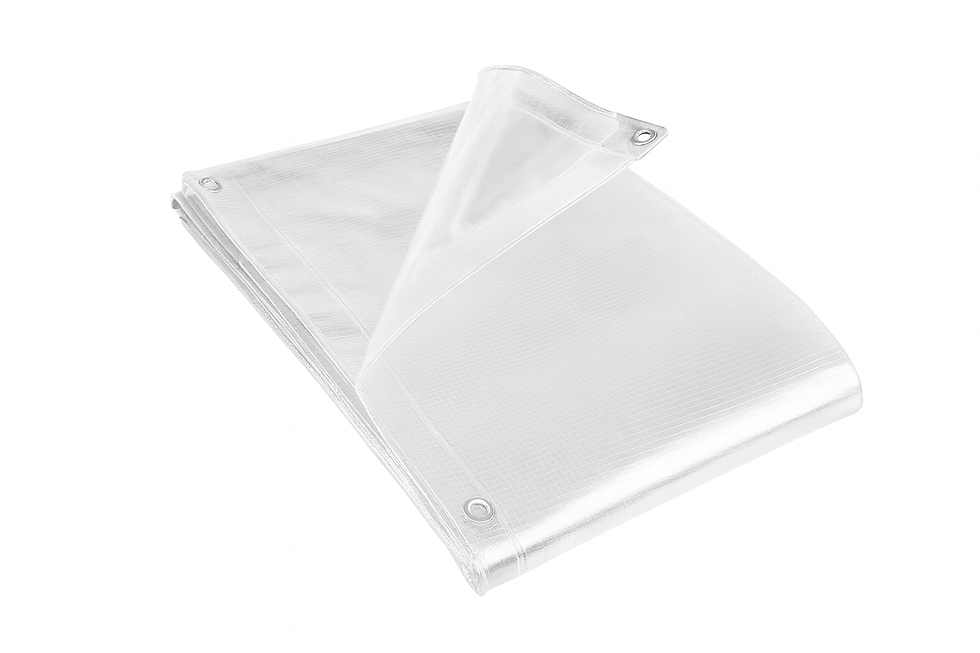The Importance of Reinforced Corners on Tarpaulins
- UK Tarps
- Jun 1, 2024
- 4 min read
Waterproof Tarpaulin sheets are wide mats of thin, heavy-duty, waterproof material that is used for many purposes such as to cover woods, tools, and equipment as well as to provide makeshift shelters. One structural feature that can be neglected but should not be in the corners with grommets that add some sturdiness and safety to the tent. Now let’s dive deep into why corners are so important especially when reinforced on a tarpaulin.
Preventing Tears
One should note that the corners of a tarpaulin are the areas that are most frequently exposed to stress and strain during the product’s actual usage. When using ropes or straps to wrap the tarp, the majority of the tension ends up being applied to the corner points. The corners have no support and as such when the canopy is being used they are likely to have minor tears that can spread over the entire cover of the tarp thus reducing its functionality. Still, tarpaulin with robust corners with extra fabric layers or patches applied to cause the forces to spread all over. This helps to minimize any possibility of critical corner tears despite constant stretching of the material to the extent of taut repeatedly over time. As for temporary shades and covers that are designed to be used under weather elements, reinforced corner technology is an important aspect.
Anchor Point Stability
Besides blocking tear development at corners, reinforcement also ensures that tarpaulins have properly fixed grommets or their anchor points. They are metallic, rubber, or any other material that is installed into the thicker reinforced fabric at the point where the rope, bungee cords, or straps have holes for fixing. The reinforcements give a firm base to the grommets to prevent them from being torn out by high wind, snow, or rain loads. If reinforcements are not provided then the grommets or other eyelets may pop out from the thin membrane fabric on their own. Making sure that the corner has stability and security in terms of anchor points turns very floppy and ineffective tarps into very strong and durable shelters that could last as long as the installation.
Structural Rigidity Boost
The reinforced corners are also vital as they provide support to the tarpaulin and avoid sagging, buckling, and slipping in cases of an outdoor installation. For example, just one corner that has dropped can collect large volumes of water or cascading failure because lines drag other corners down. The dimensional stability of each reinforced corner ensures the proper coverage and tension on the tarp in all directions is maintained throughout the length and width regardless of weather elements. This enables the tarp to perform expectedly, to shield it from rain and sunlight as required throughout the shelter. The additional supports place the tarp in the correct position and also secure it well.

Safety Factor
In other words, when shielding equipment, other apparatus, or people below with Clear Tarpaulin sheets for tents or rain fly covers, the incidence of structural corner failure or tear is higher depending on the height and angle of application. Additional strength at corners contributes to safety requirements to minimize dangerous loosening, excessive swaying, or violent flapping in the wind, or, on the other hand, sudden failing. The reinforcement that is applied to every corner of institutional-grade tarpaulins is meant to handle overloading conditions and to remain fastened to the shelter or equipment, as the case may be, to reduce risk. The lack of reinforcements required to enhance load-bearing capacities poses threats that may not be tolerable for human lives and valuable items located under tarp installations.
Improved Stake Holding
Most tarp designs incorporate stakes, screws, or pegs to secure the tarp’s corners to the ground or the structure upon which it is placed. With reinforced corners that have grommets, the material offering is improved and the anchoring hardware can have some contact past the thin outer layer of the fabric and get a better grip on the fabric when the load is applied. One disadvantage of the single-ply fabric is that it is thinner, and stakes can pull through or come undone with higher winds or make tension adjustments. But reinforced corners are even more effective in terms of pull-out resistance to ensure that the shelters do not float. This stake-holding capacity along with the added strength of grommets also helps to provide secure anchoring in the tactical field applications.
Higher Wind Rating
Many product tests that go along with manufacturing an effective corner reinforcement system enable companies to advise their clients on wind speed load capacity according to the hardware, fabrics, and dimensions used. While conventional polyethylene Tarpaulin Sheet has an average thickness of 6 mil, it is only capable of handling a short duration of 25 mph winds before it is damaged or blown away. Thickly layered corners of vinyl can enhance the rating to the wind for enhanced performance up to 40 mph or more. Depending on the nature of the material used with polyester canvas fabric and double thick corner layers, some of the tarps are even designed to withstand winds of over 60 mph. The reinforcement technology directly enables much higher wind ratings, which is the principal reason that it has been adopted.
Conclusion
In summary, some parts of a conventional, mundane, and simple azure ground cloth become essential load-bearing points when the enhancements are layered. This relatively minor added function yields major benefits to both, longevity, function, and safety for virtually all tarp shelter, cover, and containment uses for consumer and business purposes. When making comparisons for the next purchase or project, ensure that the manufacturer has indeed included superior construction of reinforced corners in the tarp.



Comments